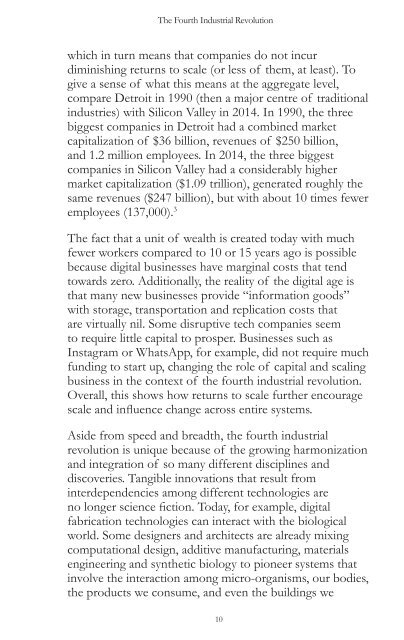The Fourth Industrial Revolution
WEF_The_Fourth_Industrial_Revolution
WEF_The_Fourth_Industrial_Revolution
You also want an ePaper? Increase the reach of your titles
YUMPU automatically turns print PDFs into web optimized ePapers that Google loves.
<strong>The</strong> <strong>Fourth</strong> <strong>Industrial</strong> <strong>Revolution</strong><br />
which in turn means that companies do not incur<br />
diminishing returns to scale (or less of them, at least). To<br />
give a sense of what this means at the aggregate level,<br />
compare Detroit in 1990 (then a major centre of traditional<br />
industries) with Silicon Valley in 2014. In 1990, the three<br />
biggest companies in Detroit had a combined market<br />
capitalization of $36 billion, revenues of $250 billion,<br />
and 1.2 million employees. In 2014, the three biggest<br />
companies in Silicon Valley had a considerably higher<br />
market capitalization ($1.09 trillion), generated roughly the<br />
same revenues ($247 billion), but with about 10 times fewer<br />
employees (137,000). 3<br />
<strong>The</strong> fact that a unit of wealth is created today with much<br />
fewer workers compared to 10 or 15 years ago is possible<br />
because digital businesses have marginal costs that tend<br />
towards zero. Additionally, the reality of the digital age is<br />
that many new businesses provide “information goods”<br />
with storage, transportation and replication costs that<br />
are virtually nil. Some disruptive tech companies seem<br />
to require little capital to prosper. Businesses such as<br />
Instagram or WhatsApp, for example, did not require much<br />
funding to start up, changing the role of capital and scaling<br />
business in the context of the fourth industrial revolution.<br />
Overall, this shows how returns to scale further encourage<br />
scale and influence change across entire systems.<br />
Aside from speed and breadth, the fourth industrial<br />
revolution is unique because of the growing harmonization<br />
and integration of so many different disciplines and<br />
discoveries. Tangible innovations that result from<br />
interdependencies among different technologies are<br />
no longer science fiction. Today, for example, digital<br />
fabrication technologies can interact with the biological<br />
world. Some designers and architects are already mixing<br />
computational design, additive manufacturing, materials<br />
engineering and synthetic biology to pioneer systems that<br />
involve the interaction among micro-organisms, our bodies,<br />
the products we consume, and even the buildings we<br />
10


